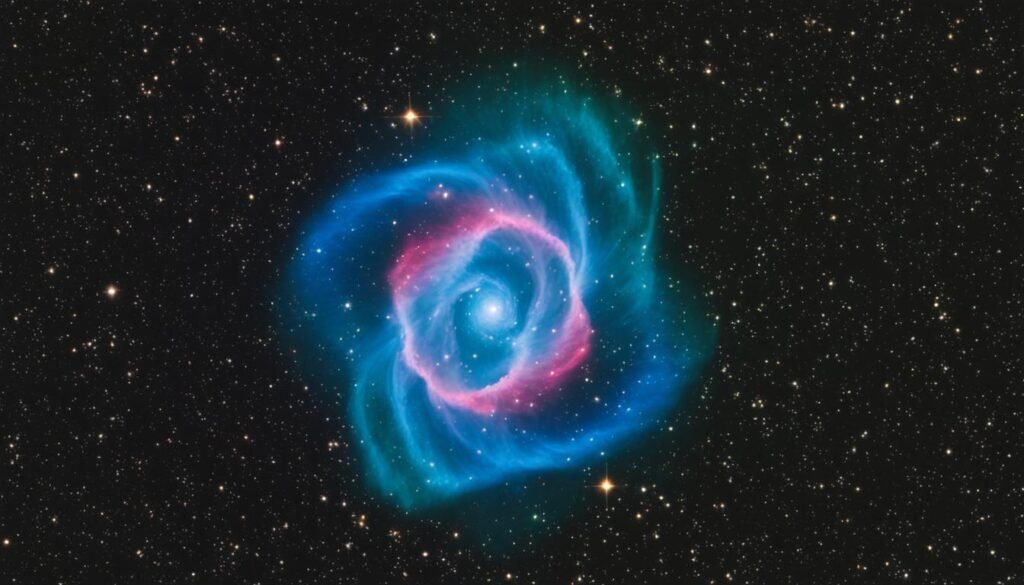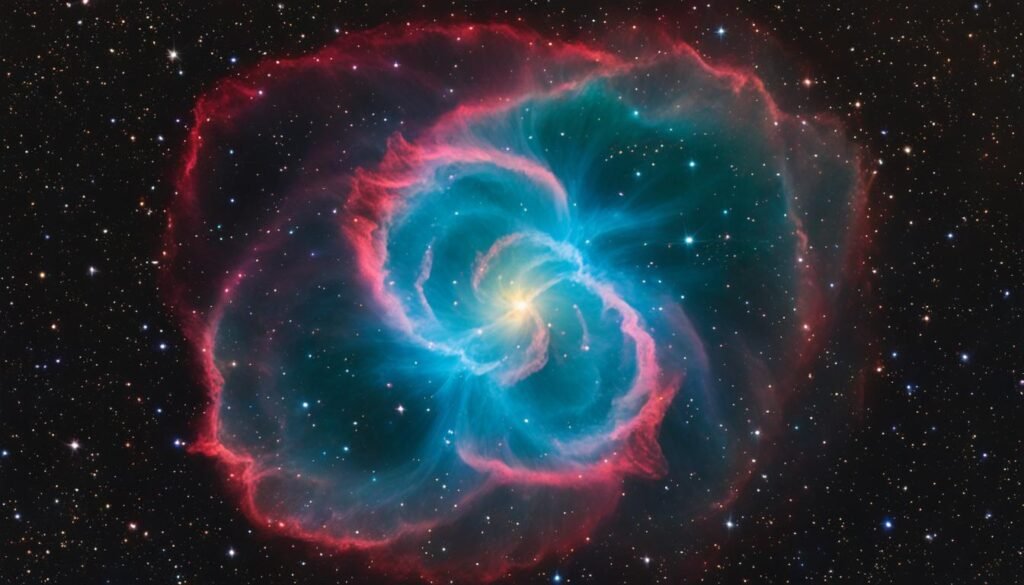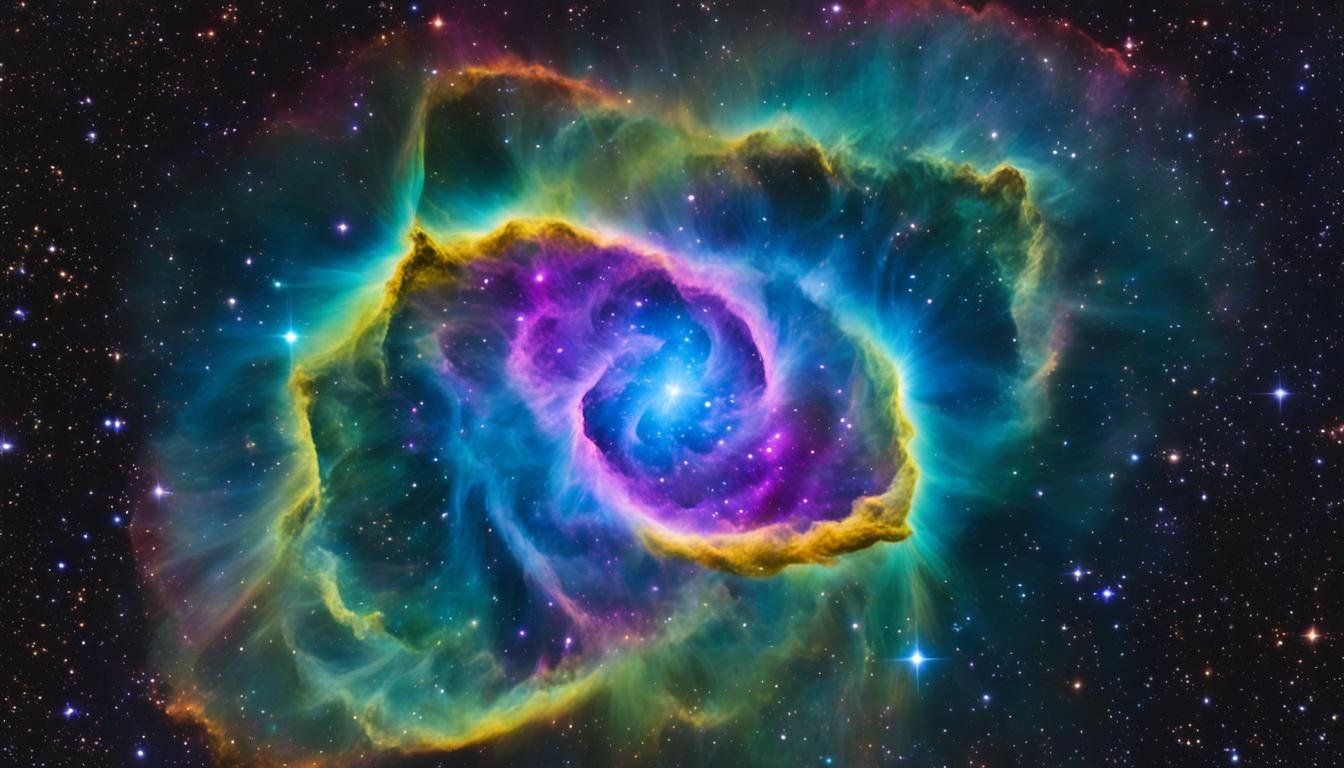Welcome to our exploration of celestial objects! In this article, we will delve into the fascinating realm of deep-sky wonders and take a closer look at Messier 76, also known as the Little Dumbbell Nebula. Situated in the constellation Perseus, this planetary nebula offers a captivating glimpse into the awe-inspiring beauty of our universe. So, let’s embark on this celestial journey together and discover the wonders of Messier 76.
Key Takeaways:
- Messier 76, also known as the Little Dumbbell Nebula, is a planetary nebula located in the constellation Perseus.
- It was discovered by Pierre Méchain in 1780 and included in Charles Messier’s catalog of comet-like objects.
- Messier 76 is a bipolar planetary nebula with a central star and two lobes or wings.
- The nebula has a radius of 0.617 light years and shines with the combined light of its central star and the luminous envelope surrounding it.
- Located in the eastern part of the Perseus constellation, Messier 76 is easily accessible for observation and exploration.
Overview of Messier 76
Messier 76, also known as the Little Dumbbell Nebula, is an intriguing celestial object located in the constellation Perseus. This planetary nebula gained its name due to its resemblance to the larger Dumbbell Nebula. It is also sometimes referred to as the Barbell Nebula or the Cork Nebula. Messier 76 holds a special place in astronomy as it was included as number 76 in Charles Messier’s catalog of comet-like objects.
This captivating nebula showcases the extraordinary diversity found in the depths of outer space. As a bipolar planetary nebula, Messier 76 consists of a central star or planetary nebula nucleus surrounded by two lobes or wings. Its unique structure and intricate details make it a favorite target for both amateur astronomers and professional scientists.
Take a look at this mesmerizing image of Messier 76, the Little Dumbbell Nebula:
Key Features of Messier 76:
| Common Names | Designation |
|---|---|
| Little Dumbbell Nebula | M76 |
| Barbell Nebula | |
| Cork Nebula |
As observed from its various monikers, Messier 76 has garnered attention for its striking shape and mesmerizing appearance. Explore further to uncover the physical characteristics and intriguing details of this astonishing planetary nebula.
Physical Characteristics of Messier 76
Messier 76, also known as the Little Dumbbell Nebula, is a captivating planetary nebula with unique physical characteristics. Exploring the physical properties of this celestial object provides valuable insights into its structure and composition.
Radius
The radius of Messier 76 is approximately 0.617 light years. This measurement helps astronomers understand the size and extent of the nebula. With a radius of this magnitude, the Little Dumbbell Nebula showcases its intricate structure, including the two lobes or wings that extend from its central star.
Apparent Magnitude and Size
Messier 76 has an apparent magnitude of +10.1, which indicates its brightness as observed from Earth. In the sky, the nebula spans approximately 2.7 by 1.8 arc minutes, making it a relatively compact object. Despite its small size, the Little Dumbbell Nebula captures the attention of astronomers and stargazers alike with its distinct shape and intricate details.
Surface Temperature
The central star or planetary nebula nucleus of Messier 76 has an incredibly high surface temperature of about 88,400 K. This intense heat contributes to the glowing clouds and luminous nature of the nebula. In contrast, the nebula itself has a temperature of about 60,000 K. Understanding these surface temperatures helps astronomers further analyze the physical processes and energy sources within the Little Dumbbell Nebula.
Location of Messier 76
Messier 76, the Little Dumbbell Nebula, is located in the constellation Perseus. Situated in the eastern part of the constellation, it can be found near the border with Andromeda. To locate M76, simply look south of Cassiopeia’s W asterism and about a degree north-northwest of the magnitude 4.0 star Alseiph, Phi Persei. Notably, this nebula shares the same region of the sky as the Andromeda Galaxy (M31). Its convenient position makes it easily accessible for observation and exploration, making it a popular target for both amateur astronomers and astrophotographers.
To add further context, the Perseus constellation is named after the Greek hero Perseus, known for his triumphs over mythological creatures. Andromeda Galaxy (M31) is a spiral galaxy located approximately 2.537 million light-years away from Earth. It is the nearest major galaxy to our own Milky Way.
Celestial Objects in the Perseus Constellation
| Name | Type | Apparent Magnitude |
|---|---|---|
| Messier 76 | Planetary Nebula | +10.1 |
| Perseus A (NGC 1275) | Elliptical Galaxy | +11.9 |
| Mirfak (Alpha Persei) | Binary Star | +1.79 |
| Algol (Beta Persei) | Eclipsing Binary Star | +2.09 to +3.39 |
Note: Apparent magnitude is a measure of the brightness of a celestial object as observed from Earth. The lower the magnitude, the brighter the object appears.
Observing Messier 76
Messier 76, the Little Dumbbell Nebula, can be observed using a variety of telescopes. Whether you have a small telescope or a larger instrument, you can catch a glimpse of this captivating celestial object.
When observing Messier 76 with a small telescope, it appears as a small, diffuse point of light in the night sky. However, as the size of the telescope increases, you can start to distinguish the two lobes and the dark lane that separates them. With larger telescopes, you can even see the faint halo surrounding the nebula, revealing its intricate structure.
The optimal time to observe the Little Dumbbell Nebula is during the months of October, November, and December. During this period, the nebula is well-placed in the sky for viewing and offers the best opportunities to capture its beauty.
It’s important to note that observing Messier 76 can be challenging for those in the southern hemisphere. As it is located in the northern part of the sky, the nebula never climbs high above the northern horizon when visible from southern locations.
| Telescope Size | Observing Experience |
|---|---|
| Small | M76 appears as a small, diffuse point of light |
| Medium | The two lobes and the dark lane become more apparent |
| Large | Both the double-lobed structure and the faint halo are visible |
By observing Messier 76, the Little Dumbbell Nebula, you can witness the wonders of our universe and marvel at its intricate beauty.

The Significance of Messier 76
Messier 76, the Little Dumbbell Nebula, holds great significance as one of the four planetary nebulae included in Charles Messier’s renowned catalog. Alongside the Dumbbell Nebula (M27), the Ring Nebula (M57), and the Owl Nebula (M97), Messier 76 stands out for its unique and captivating qualities. Its inclusion in the Messier Catalogue highlights its importance as a noteworthy object for astronomers and enthusiasts alike, providing a window into the diverse and stunning world of planetary nebulae.
The Formation of Messier 76
Messier 76, also known as the Little Dumbbell Nebula, is a planetary nebula that was formed through a remarkable process involving a dying star. In the late stages of its life, a Sun-like star exhausted its fuel and underwent a dramatic transformation.
The star expelled its outer layers, creating a shell of gas and dust around its core. The expelled material was then heated by the intense radiation emitted by the star’s remaining core, known as the central star or planetary nebula nucleus.
This heating process caused the expelled material to glow brightly, giving rise to the luminous clouds we see as the Little Dumbbell Nebula. The intricate structure and delicate colors of the nebula are a testament to the complex dynamics at work during its formation.
The central star of Messier 76 is a white dwarf remnant, which is the hot, dense core that remains after a star exhausts its nuclear fuel. Over time, the white dwarf will gradually cool down and fade away.
Meanwhile, the clouds of the nebula will disperse into the surrounding interstellar medium, where the gas and dust will contribute to the formation of new stars and planetary systems. This gradual dispersal marks the completion of the life cycle of the Little Dumbbell Nebula.
Key Points:
- Messier 76 formed from the expelled outer layers of a dying Sun-like star.
- The expelled material was heated by the radiation of the central star, creating the glowing clouds of the nebula.
- The central star of Messier 76 is a white dwarf remnant that will eventually cool and fade away.
- Over time, the clouds of the nebula will disperse into the interstellar medium, completing the life cycle of the planetary nebula.
Did You Know?
“The formation of planetary nebulae like Messier 76 is a spectacular celestial event, showcasing the intricate beauty of the universe.”- Astronomer
Discoveries and Observations of Messier 76
Messier 76, also known as the Little Dumbbell Nebula, has fascinated astronomers throughout history with its unique characteristics and captivating beauty. Let’s explore some of the noteworthy discoveries and observations made by astronomers over the years.
Discovery and Inclusion in Messier’s Catalog
In 1780, Pierre Méchain first discovered Messier 76 while observing the night sky. Impressed by its appearance, Méchain reported his finding to fellow astronomer Charles Messier, who included it in his catalog of comet-like objects as number 76. This marked the beginning of our formal recognition of this celestial wonder.
“I have observed a nebula in Perseus.
RA = 3h 0.5m, Dec = +52d 6′ 3″ (1780).
Rounded shape, pale light, difficult to see.”Pierre Méchain
William Herschel’s Observations
In 1783, British astronomer Sir William Herschel made significant observations of Messier 76 using his larger telescope. He discovered that what was previously thought to be a single nebula was, in fact, two separate nebulae. Herschel’s observations brought attention to the complex structure of this celestial object.
Isaac Roberts’ Photographic Proof
In 1891, Isaac Roberts took the first photographic image of Messier 76, providing visual evidence of its unique shape and intricate details. His photograph confirmed the double-lobed structure of the nebula, further adding to our understanding of its true nature.
Recognition as a Planetary Nebula
It was not until 1918 that American astronomer Heber Doust Curtis officially recognized Messier 76 as a planetary nebula. Curtis’s discovery solidified the understanding that planetary nebulae, although appearing planet-like in early telescopes, are actually shells of gas and dust expelled by dying stars.
| Name | Year | Contribution |
|---|---|---|
| Pierre Méchain | 1780 | Discovery |
| William Herschel | 1783 | Identified the double-lobed structure |
| Isaac Roberts | 1891 | Provided the first photographic evidence |
| Heber Doust Curtis | 1918 | Recognized it as a planetary nebula |
These discoveries and observations by dedicated astronomers have significantly contributed to our knowledge and appreciation of Messier 76, revealing its intricacies and unveiling the secrets of the cosmos.

Challenges and Rewards of Observing Messier 76
Observing Messier 76, the Little Dumbbell Nebula, can be a thrilling yet demanding endeavor. The nebula’s faintness and small apparent size pose significant challenges, particularly for observers using small telescopes. However, the rewards that await dedicated enthusiasts are well worth the effort.
When it comes to observing Messier 76, larger telescopes in the 200-250mm (8-10 inch) range prove to be exceedingly beneficial. These instruments have the capability to reveal the nebula’s distinctive shape and intricate nebulosity, providing a more detailed and awe-inspiring view. Additionally, employing narrowband filters like the Ultra High Contrast (UHC) or Oxygen III (O-III) filter can further enhance the visual experience, bringing out the finer details of the Little Dumbbell Nebula.
For amateur astronomers and astrophotographers, observing and photographing Messier 76 offer a unique and rewarding experience. Capturing the ethereal beauty and intricate structure of this celestial wonder allows one to appreciate the vastness and complexity of the universe. It is through the dedicated exploration of challenging objects like Messier 76 that aspiring stargazers can unlock a world of wonders and deepen their love for the cosmos.
The Rewards of Observing Messier 76
Here are the key rewards that await those who embark on the journey to observe Messier 76:
- Visually Captivating: Larger telescopes reveal the nebula’s distinctive and intricate shape, allowing observers to immerse themselves in its magnificence.
- Photographic Opportunities: Through astrophotography, enthusiasts can capture the ethereal beauty of the Little Dumbbell Nebula, preserving its awe-inspiring features.
- Deepens Understanding: Observing Messier 76 presents an opportunity to delve into the complexities of planetary nebulae, expanding one’s knowledge and appreciation of celestial objects.
Observed Challenges
Here are the main challenges that observers may encounter when attempting to study and capture the Little Dumbbell Nebula:
- Faintness: The nebula’s faint nature makes it a challenging target, especially for observers using smaller telescopes.
- Small Apparent Size: The diminutive size of Messier 76 requires higher-quality optics to resolve its intricate details adequately.
- Conditions and Light Pollution: Observing the Little Dumbbell Nebula may be hindered by adverse atmospheric conditions or light pollution, requiring optimal viewing conditions.
Final Thoughts
“The endeavor of observing Messier 76, the Little Dumbbell Nebula, may be a test of dedication and perseverance. However, the rewards that await those willing to rise to the challenge are nothing short of awe-inspiring. By venturing beyond the limits of what seems feasible, stargazers can unlock the secrets of the universe and find profound beauty in the depths of the cosmos.”
Conclusion
Messier 76, the Little Dumbbell Nebula, located in the constellation Perseus, is a captivating celestial object that showcases the beauty and diversity of deep-sky wonders. Formed during the last stages of a dying star’s life, its intricate structure and delicate nebulosity provide a mesmerizing sight for astronomers and enthusiasts alike.
Although observing the Little Dumbbell Nebula can pose challenges, the rewards are well worth the effort. Whether using a small telescope or a larger instrument, exploring and studying Messier 76 allows you to appreciate the wonders of the cosmos in a unique way. Witnessing its distinctive shape and intricacies offers a deeper understanding of the incredible phenomena that occur in our universe.
As you gaze upon Messier 76, you are reminded of the vastness and complexity of the cosmos. It serves as a reminder of the beauty and mysteries that lie beyond our planet. So, get your telescope ready, find the constellation Perseus, and immerse yourself in the awe-inspiring sight of the Little Dumbbell Nebula, a true cosmic gem.
FAQ
What is Messier 76, the Little Dumbbell Nebula?
Messier 76, also known as the Little Dumbbell Nebula, is a planetary nebula located in the constellation Perseus. It was discovered by Pierre Méchain in 1780 and included in Charles Messier’s catalog of comet-like objects as number 76.
What are the physical characteristics of Messier 76?
Messier 76 has a radius of 0.617 light years and an apparent magnitude of +10.1. The central star or planetary nebula nucleus has a surface temperature of about 88,400 K, while the nebula itself has a temperature of about 60,000 K.
Where is Messier 76 located?
Messier 76 is located in the constellation Perseus, in the eastern part of the constellation near the border with Andromeda. It is just south of Cassiopeia’s W asterism and about a degree north-northwest of the star Alseiph, Phi Persei.
How can Messier 76 be observed?
Messier 76 can be observed using a variety of telescopes. Small telescopes will show it as a small, diffuse point of light, while larger telescopes can reveal its double-lobed structure and the faint halo surrounding it. The best time to observe it is during the months of October, November, and December.
What is the significance of Messier 76?
Messier 76 holds significance as one of only four planetary nebulae listed in Charles Messier’s catalog. Its inclusion in the catalog showcases its unique and captivating qualities, making it a noteworthy object for astronomers and enthusiasts.
How was Messier 76 formed?
Messier 76 was formed when a Sun-like star exhausted its fuel and expelled its outer layers in a late stage of its life. The expelled material was then heated by the radiation of the central star, creating the glowing clouds that we see as the nebula.
What are some notable discoveries and observations of Messier 76?
Messier 76 was originally discovered by Pierre Méchain in 1780 and later included in Charles Messier’s catalog. William Herschel observed it as two separate nebulae, and Isaac Roberts provided the first photographic evidence of its true nature in 1891. Heber Doust Curtis was the first to recognize it as a planetary nebula in 1918.
What are the challenges and rewards of observing Messier 76?
Observing Messier 76 can be challenging due to its faintness and small apparent size. However, larger telescopes in the 200-250mm (8-10 inch) range can reveal its distinctive shape and intricate nebulosity. Narrowband filters can further enhance the view. The rewards of observing and photographing the Little Dumbbell Nebula provide a unique and rewarding experience for amateur astronomers.
Conclusion
Messier 76, the Little Dumbbell Nebula, is a captivating and unique celestial object located in the constellation Perseus. Its beauty and diversity showcase the wonders of the cosmos and provide opportunities for exploration and study for astronomers and enthusiasts alike.






